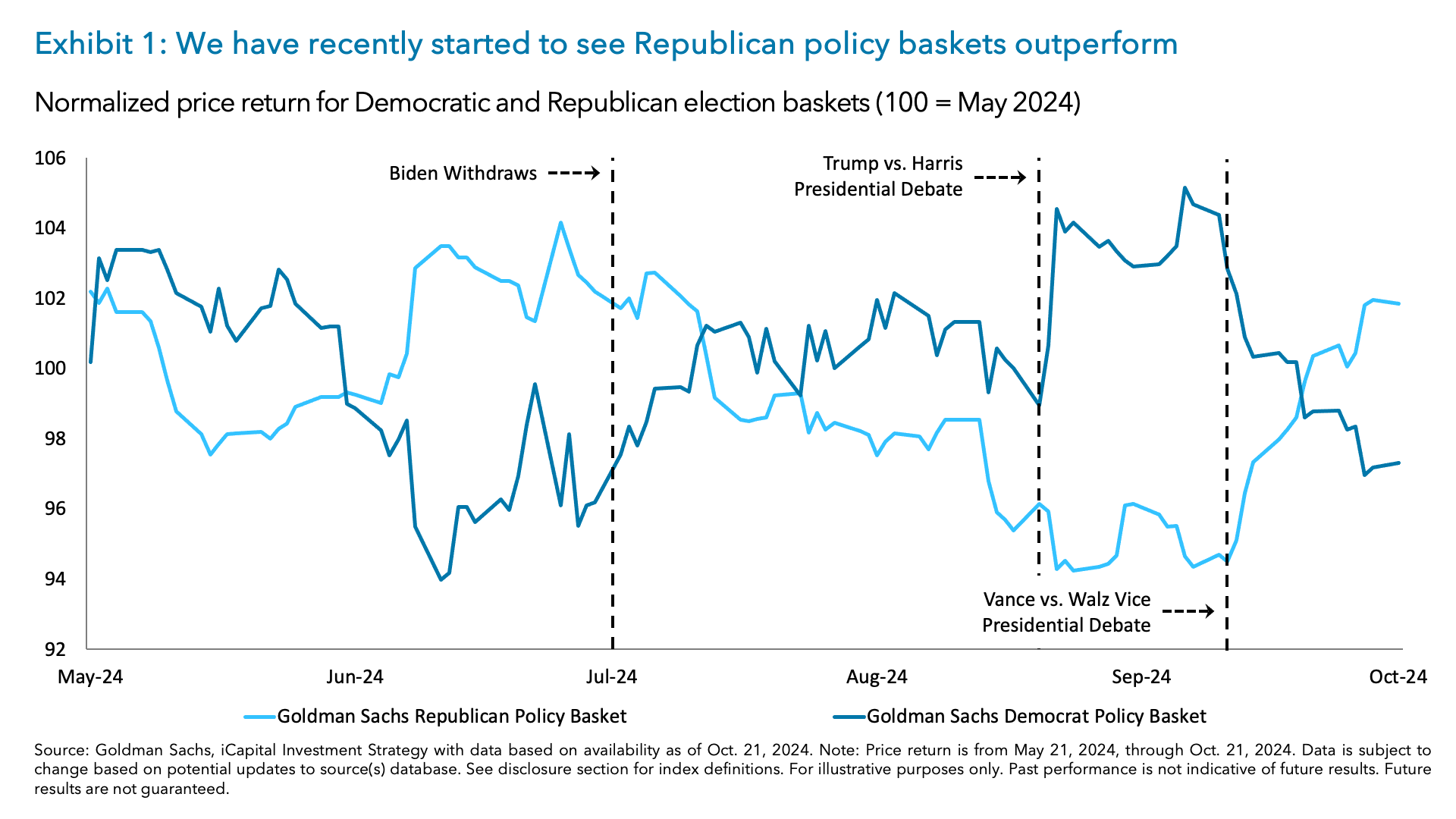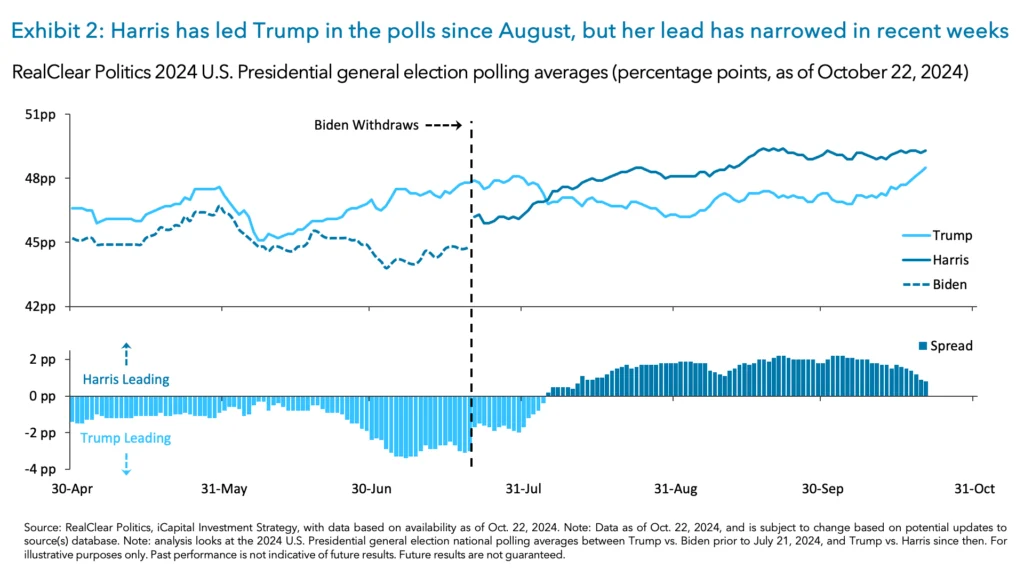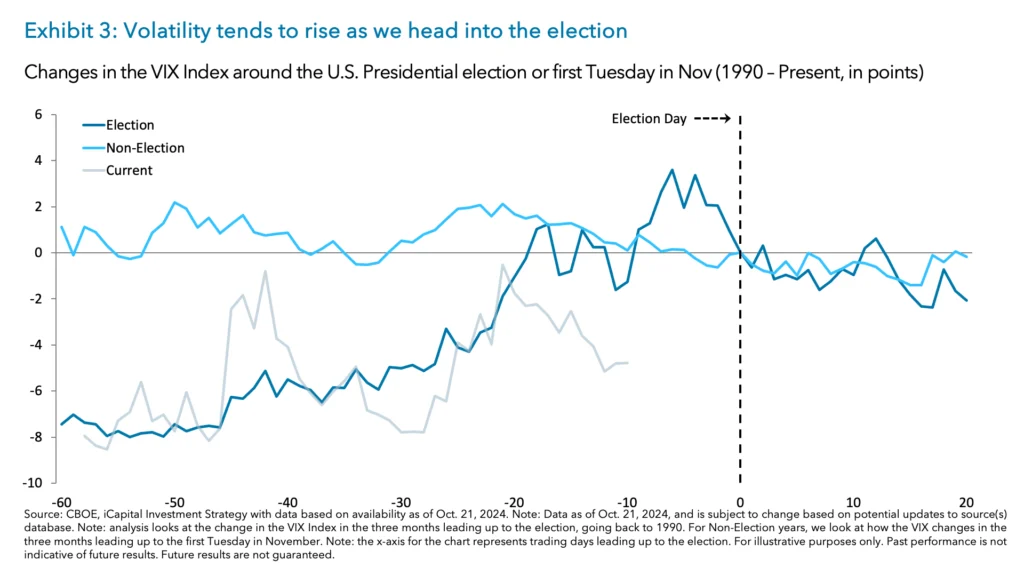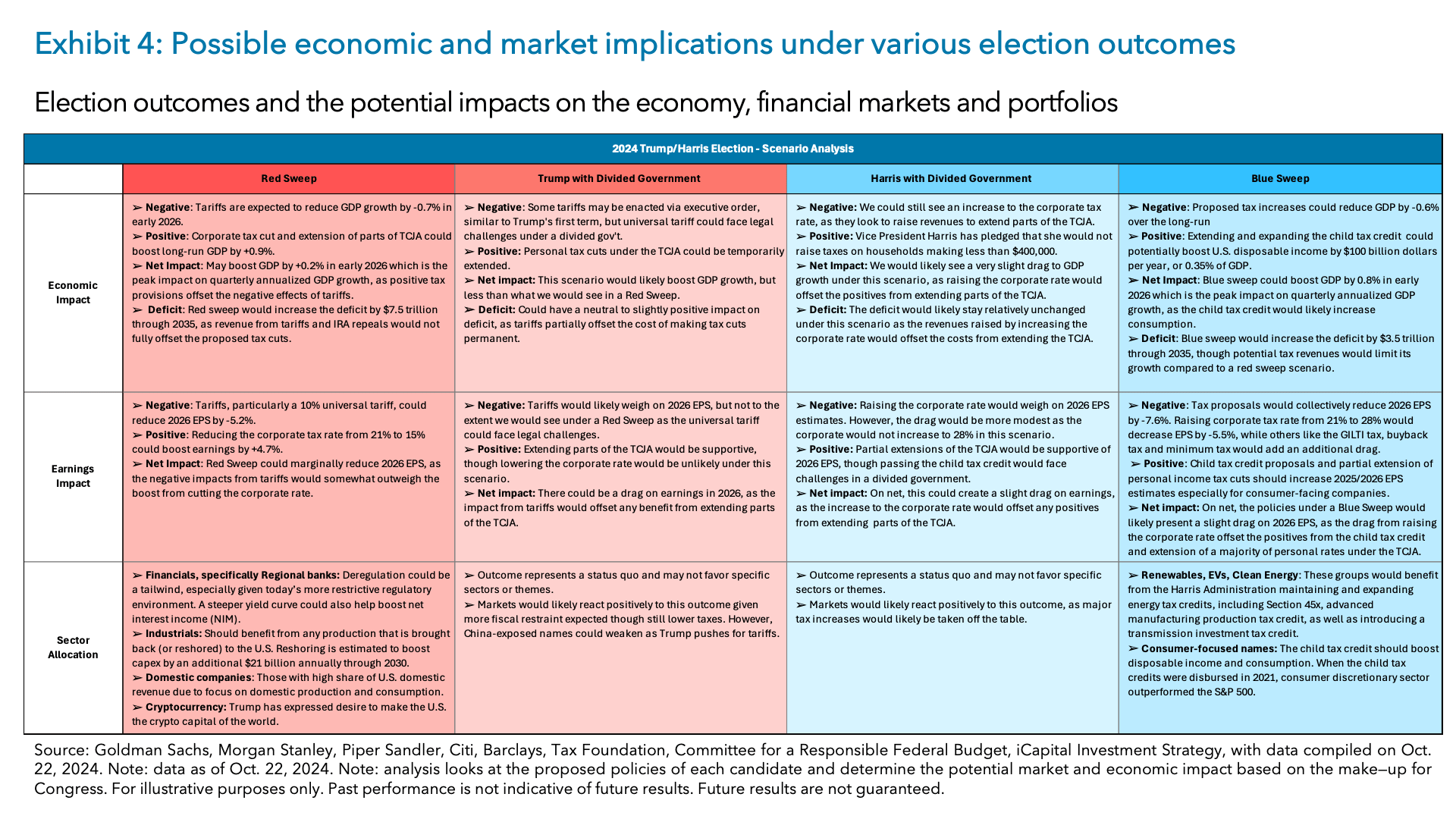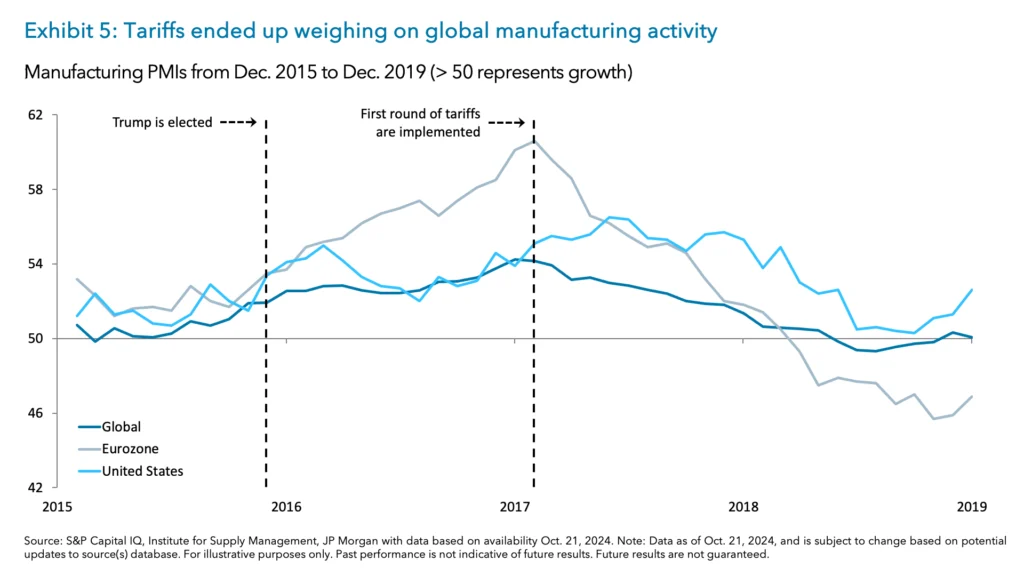With the U.S. presidential election now less than two weeks away, investors are keenly focused on the potential outcomes and their possible impact on the economy. Moreover, some markets are even starting to price in various election outcomes. While the polls show a close race (see details below), an area that has caught investors’ attention is the recent moves in election odd markets. Indeed, Real Clear Politics (RCP) election odds, the average of eight different election odds providers, show the former President with roughly a 22-percentage point (ppt) lead over Kamala Harris.1 And in accordance with that, the Goldman Sachs (GS) Republican Policy basket has outperformed the GS Democrat Policy basket by 7.3% since the start of September as seen in Exhibit 1.
Importantly, because this is an incredibly close race and uncertainty around the final outcome is high, pre-positioning is likely premature. But, based on prior election cycles, we believe this uncertainty and volatility will subside once the outcome is known. As a result, any election-related market weakness could represent an opportunity for investors to add to their equity allocation. Ultimately, however, each candidate’s policy proposals could impact specific sectors and industry groups and create divergences within the market.
In this commentary we review the current state of the race, each candidate’s key policy proposals, and how their proposals could impact the economy, earnings and markets.
A very close election is expected, which could raise uncertainty and volatility
A tight race is expected between Vice President Harris and former President Trump, as the national polls show the Vice President maintaining a 0.8 ppt lead – well within the margin of error of roughly 2%.2 Current polling in swing states is another indication of a close race, as the former President has a slight lead of +1.2 ppt – also well within the margin of error.3 To put into perspective how close this race will be, Nate Silver, founder of the FiveThirtyEight opinion poll website, recently noted that he’s “never seen an election in which the forecast spent more time in the vicinity of 50/50.”4
Given the race is very close and the outcome will be decided in a small handful of states or even counties, uncertainty, and therefore volatility may stay elevated or rise further into the election. Implied volatility for S&P 500 options expiring the Friday after the election (Nov 8th) is approximately 16 and is expected to slowly normalize towards 14.1 into year-end, assuming the outcome of the election becomes clear.5
When looking at expected volatility, proxied by the VIX index, it has historically increased by an average of +10 points in the three-months leading up to the election.6 This compares to non-election years when the VIX has been roughly unchanged in the three-months leading up to the first Tuesday in November.7 This time around, we have seen the index rise from 15.2 to 22.6 or 7.4 points, before the recent pullback to 18.4.
The forward curve indicates that volatility could rise further into the election, albeit not much higher from current levels. Indeed, the October VIX contract – a proxy for the volatility market pricing of election risk – currently stands at 18.4.8 Looking back at the 2020 presidential election, the VIX index rose by 11 points in the second half of October.9 Therefore, as we discussed in our last Market Pulse (here), we would not be surprised to see volatility rise, especially as positioning is elevated and the S&P 500 remains close to overbought territory and yields are once again becoming a concern.
Grand policy proposals are not likely to sizably sway the economy in either direction (due to offsets and especially without a sweep)
The equity market strength so far year-to-date seems to be reflecting a high conviction in the soft-landing scenario, and investors are (rightfully) turning their focus to what could derail that – the risks of each Presidential candidate’s policy proposals. While there have been policies discussed by both candidates that could weigh on both economic and earnings growth, we believe there are also positive offsets. Although sometimes overlooked, together they may help reduce any drag on the economy and earnings in 2026.
We detail the positive and negative impacts on the economy, earnings and sectors in the table below. Unsurprisingly, the outcomes are expected to vary not only depending on who wins the White House, but also on the composition of Congress.
Harris – impact of higher taxes, but offset with greater tax credits
Under a Harris administration a likely focus will be on increasing tax rates – particularly the corporate rate. In fact, we would expect proposals to increase the corporate rate to 28%.10 In addition, the minimum tax would likely rise from 15 to 21%, the global intangible low-taxed income (GILTI) tax would rise to 21% and the buyback tax would likely quadruple to 4%.11 From a personal rate perspective, we would likely see the top-income bracket rise to 39.6%. However, raising these tax rates will ultimately depend on the make-up of Congress. If we get a Harris Presidency and a divided Congress (either the Senate or the House of Representatives is Republican controlled), it could be more challenging for her Administration to enact these tax increases.
While these tax increases could pose a risk to earnings and growth, there are policy proposals that could provide positive offsets to economic growth and earnings. Namely, the Harris Administration would look to reinstate and expand the child tax credit. This proposal would reinstate the child tax credit under The American Rescue Plan – $3,600 for children under 6 and $3,000 for children under 18 – and introduce a $6,000 credit for the first year of life.12 This would represent an increase from the current credit of $2,000 for children under the age of 17.13 Additionally, while the corporate rate would likely rise under a Harris Presidency, this could be offset by extending parts of the Tax Cuts and Jobs Act (TCJA), as she has pledged to not raise taxes on families making less than $400,000. Other potential pro-growth policy proposals would also include a $25,000 down payment support for first time homebuyers and increasing the small business tax deduction to $50,000.
What would this mean for economic growth? According to the Tax Foundation, raising the corporate tax rate to 28% is estimated to shave 0.6% off of long-run GDP.14 However, the reinstatement and expansion of the child tax credit could potentially boost U.S. disposable income by $100 billion dollars per year.15 In aggregate, it is estimated that a blue sweep could boost GDP by 0.8% in early 2026 (which is the peak impact on quarterly annualized GDP growth), as the child tax credit would likely increase consumption.16
However, the changes in tax policy would likely have a bigger impact on earnings expectations in 2026. Indeed, the potential tax increases could subtract 7.6% off of 2026 earnings.17 Based on various estimates, increasing the corporate rate to 28% would have the largest impact and by itself is estimated to subtract 5.5% off of corporate earnings for 2026.18 Still, the offset to the negative hit to EPS would be the positive impact of additional disposable income available due to the expanded child tax credit.
Trump – impact of tariffs, but coupled with a lower corporate tax rate
Under a Trump Administration, we believe tariffs will be a focal point as the former President stated as recently as last week that “the most beautiful word in the dictionary is tariff.”19 He has previously discussed raising tariffs on China to 60% and a 10% universal tariff. Whether the Trump Administration would be able to legally implement a universal tariff without congressional approval is uncertain. During President Trump’s first administration, the tariffs were enacted through executive order due to national security, and it’s not clear if the same executive order could be used for universal tariffs. Nevertheless, former trade representative Robert Lighthizer believes that the President could utilize the International Emergency Economic Powers Act (IEEPA) and Section 338 of the Tariff Act of 1930 to enact an across-the-board tariff via executive order.20 While tariffs could pose a risk to growth and inflation, the former President and his advisors have also discussed how tariffs could be used as a negotiating tool, for example to drive investments and manufacturing activity like car production back to the U.S., something he recently mentioned at the Chicago Economics Club event.21
Despite tariffs posing a risk to the economy and earnings, a second Trump term would also feature positive policy offsets. Indeed, the former President has discussed cutting the corporate tax rate to a range of 15-20%. In addition, the Trump Administration would also look to extend the TCJA, which would include maintaining the individual rates that are set to expire at the end of the year and restoring the bonus depreciation to 100%, which would likely boost small business lending.
How big would the economic impact be? While the impact to growth and inflation from tariffs was relatively small during Trump’s first term, given the broader scope of the new round of proposed tariffs, they could have a more pronounced impact. Indeed, based on initial estimates, the proposed tariffs could add between 0.9-1.1% to inflation – only taking a few quarters to filter into prices.22 It is also estimated that these tariffs could reduce GDP growth by 0.7% in early 2026.23 We can also see how tariffs weighed on manufacturing activity both here and abroad, as the first round of tariffs coincided with the peak in purchasing manager indices (PMIs) seen in Exhibit 5.
However, this would be offset by cutting the corporate rate and extending parts of the TCJA, which is expected to boost growth by 0.9% in the long-run24 In addition, if the 100% bonus depreciation was made permanent, the Tax Foundation estimates it would boost long-run GDP by 0.4%.25
Tariffs would also weigh on earnings growth. Indeed, it is estimated tariffs could subtract about 5.2% from 2026 earnings.26 But, this drag would be offset by cutting taxes. Specifically, cutting the corporate rate to 15% is estimated to boost earnings by 4.7% in 2026.27
The bottom line of both candidates’ proposals is that along with policies which potentially boost economic growth, there are others that might slow it down. Therefore, the overall economy is not likely to be drastically swayed near-term – positively or negatively – by either candidates’ policies since the aggregate estimated impact of Vice President Harris’ policies nets out to a peak +0.8% impact on GDP in early 2026, before reversing later that the year, and the aggregate impact of former President Trump’s policies nets out to +0.2% in early 2026, with possible upside if the 100% bonus depreciation is reinstated.28 This is why we prefer to focus on the underlying fundamentals of the U.S. economy, as well as central bank policy and innovation.
Markets perform well in the year following the election, but policy will likely drive sector returns
Outside of politics and policies, the fundamentals of the U.S. economy are solid. In particular, Atlanta Q3 ’24 GDPNow remains above 3%29 and the positive revisions to consumption and savings are indicative of a strong underlying economy.
It is worth noting that equity market performance tends to be positive in the year following the presidential election. Indeed, the S&P 500 median return is +15.8% in the following year, irrespective of which party holds office.30 So, while we may continue to see volatility rise into the election, we think this could be an opportunity to add to equity risk or to rebuild any allocations that may have been de-risked ahead of the election.
What sector or factors should investors be adding exactly? There certainly will be potential winners and losers from the policy proposals discussed above. As we mentioned in the beginning, some market participants have already started to pre-position, but we view this as premature given how close of a call the election might be. However, here are the potential beneficiaries to consider once the outcome is known.
Harris – Favor Clean Energy and the Consumer
- Electric Vehicles/Clean Energy and Solar. We believe these groups would benefit the most from a Harris victory. We think the Vice President would maintain and expand energy tax credits, including Section 45x, advanced manufacturing production tax credit and introduce a transmission investment tax credit.31 A large negative risk premium is currently priced into these groups as Trump has suggested he would try to roll back parts of the Inflation Reduction Act – namely EV tax credits.
- Consumer-focused names. Given the child tax credit should boost disposable income and consumption, we think consumer oriented, specifically discretionary, companies could benefit under a Harris Presidency. Indeed, when the child tax credits were disbursed in 2021, the consumer discretionary sector outperformed the S&P 500 for the remainder of the year.32
Trump – Focus on Financials, Industrials, Domestic Beneficiaries
- Financial/Regional Banks. We think deregulation could be a tailwind, especially given today’s more restrictive regulatory environment, which includes the Basel III endgame proposals and increased capital requirements on smaller banks. Also, under a Trump Presidency, we would likely see a steeper yield curve which could help boost net interest margins (NIM).
- Reshoring Beneficiaries – Industrials. If tariffs are used as a negotiation tool to bring back various manufacturing and industrial production to the U.S., this could be supportive of industrials and other technology firms that might be beneficiaries of the expected reshoring capex. It is estimated we could see an additional $21 billion in annual manufacturing capex through 2030 in order to meet reshoring demand.33
- Companies with a high share of U.S. domestic revenue. Given the focus on tariffs and re-negotiating international trade agreements while trying to protect domestic manufacturing and domestic goods and services consumption, companies with a higher share of U.S. revenues may outperform those with a high portion of foreign revenues.
1. Real Clear Politics, as of Oct. 16, 2024.
2. Real Clear Politics, as of Oct. 15, 2024.
3. Real Clear Politics, as of Oct. 22, 2024.
4. The Hill, as of Oct. 17, 2024.
5. Bloomberg, as of Oct. 23, 2024.
6. CBOE, iCapital Investment Strategy, as of Oct. 15, 2024.
7. CBOE, iCapital Investment Strategy, as of Oct. 15, 2024.
8. CBOE, iCapital Investment Strategy, as of Oct. 21, 2024.
9. CBOE, iCapital Investment Strategy, as of Oct. 21, 2024.
10. Goldman Sachs, Morgan Stanley, JPMorgan, Strategas Research Partners, Piper Sandler, as of Oct. 17, 2024.
11. Goldman Sachs, Morgan Stanley, JPMorgan, Strategas Research Partners, Piper Sandler, as of Oct. 17, 2024.
12. Goldman Sachs, Morgan Stanley, JPMorgan, Strategas Research Partners, Piper Sandler, as of Oct. 17, 2024.
13. IRS, as of Oct. 23, 2024. Qualifications for this credit: annual income is not more than $200,000 ($400,000 if filing jointly).
14. Tax Foundation, as of Oct. 16, 2024.
15. Goldman Sachs, as of Jan. 8, 2024
16. Goldman Sachs, as of Sep. 3, 2024
17. Goldman Sachs, Morgan Stanley, Citi, and Barclays, as of Oct. 15, 2024.
18. Goldman Sachs, Morgan Stanley, Citi, and Barclays, as of Oct. 15, 2024.
19. Chicago Economics Club, as of Oct. 15, 2024.
20. Piper Sandler, as of July 25, 2024.
21. Bloomberg News, Oct. 15, 2024.
22. Goldman Sachs, Morgan Stanley, Citi, and Barclays, as of Oct. 15, 2024
23. Goldman Sachs, as of Sep. 26, 2024.
24. Tax Foundation, as of Aug. 30, 2024.
25. Tax Foundation, as of Aug. 30, 2024.
26. Goldman Sachs, Morgan Stanley, Citi, and Barclays, as of Oct. 15, 2024.
27. Goldman Sachs, Morgan Stanley, Citi, and Barclays, as of Oct. 15, 2024. Estimate is based off cutting the corporate rate to 15%.
28. Goldman Sachs, as of Sep. 3, 2024.
29. Federal Reserve Bank of Atlanta, as of Oct. 21, 2024.
30. S&P Capital IQ, iCapital Investment Strategy, as of Jan. 19, 2024.
31. Bank of America, as of Aug. 12, 2024.
32. S&P Capital IQ, as of Oct. 21, 2024.
33. Goldman Sachs, as of Oct. 12, 2023.
INDEX DEFINITIONS
S&P 500 Index: The S&P 500 is widely regarded as the best single gauge of large-cap U.S. equities. The index includes 500 of the top companies in leading industries of the U.S. economy and covers approximately 80% of available market capitalization.
VIX Index: The VIX Index is a calculation designed to produce a measure of constant, 30-day expected volatility of the U.S. stock market, derived from real-time, mid-quote prices of S&P 500® Index (SPX℠) call and put options. On a global basis, it is one of the most recognized measures of volatility -- widely reported by financial media and closely followed by a variety of market participants as a daily market indicator.
Goldman Sachs Democratic Policy Basket: The categories and equities are selected by the custom baskets desk in FICC & Equities are based on our desk views concerning the policies a Democratic government is likely to focus on.
Goldman Sachs Republican Policy Basket: The categories and equities are selected by the custom baskets desk in FICC & Equities based on our desk views concerning the policies a Republican government is likely to focus on.
IMPORTANT INFORMATION
The material herein has been provided to you for informational purposes only by Institutional Capital Network, Inc. (“iCapital Network”) or one of its affiliates (iCapital Network together with its affiliates, “iCapital”). This material is the property of iCapital and may not be shared without the written permission of iCapital. No part of this material may be reproduced in any form, or referred to in any other publication, without express written permission of iCapital.
This material is provided for informational purposes only and is not intended as, and may not be relied on in any manner as, legal, tax or investment advice, a recommendation, or as an offer or solicitation to buy or sell any security, financial product or instrument, or otherwise to participate in any particular trading strategy. This material does not intend to address the financial objectives, situation, or specific needs of any individual investor. You should consult your personal accounting, tax and legal advisors to understand the implications of any investment specific to your personal financial situation.
ALTERNATIVE INVESTMENTS ARE CONSIDERED COMPLEX PRODUCTS AND MAY NOT BE SUITABLE FOR ALL INVESTORS. Prospective investors should be aware that an investment in an alternative investment is speculative and involves a high degree of risk. Alternative Investments often engage in leveraging and other speculative investment practices that may increase the risk of investment loss; can be highly illiquid; may not be required to provide periodic pricing or valuation information to investors; may involve complex tax structures and delays in distributing important tax information; are not subject to the same regulatory requirements as mutual funds; and often charge high fees. There is no guarantee that an alternative investment will implement its investment strategy and/or achieve its objectives, generate profits, or avoid loss. An investment should only be considered by sophisticated investors who can afford to lose all or a substantial amount of their investment.
iCapital Markets LLC operates a platform that makes available financial products to financial professionals. In operating this platform, iCapital Markets LLC generally earns revenue based on the volume of transactions that take place in these products and would benefit by an increase in sales for these products.
The information contained herein is an opinion only, as of the date indicated, and should not be relied upon as the only important information available. Any prediction, projection or forecast on the economy, stock market, bond market or the economic trends of the markets is not necessarily indicative of the future or likely performance. The information contained herein is subject to change, incomplete, and may include information and/or data obtained from third party sources that iCapital believes, but does not guarantee, to be accurate. iCapital considers this third-party data reliable, but does not represent that it is accurate, complete and/or up to date, and it should not be relied on as such. iCapital makes no representation as to the accuracy or completeness of this material and accepts no liability for losses arising from the use of the material presented. No representation or warranty is made by iCapital as to the reasonableness or completeness of such forward-looking statements or to any other financial information contained herein.
Securities products and services are offered by iCapital Markets, an SEC-registered broker-dealer, member FINRA and SIPC, and an affiliate of iCapital, Inc. and Institutional Capital Network, Inc. These registrations and memberships in no way imply that the SEC, FINRA, or SIPC have endorsed any of the entities, products, or services discussed herein. Annuities and insurance services are provided by iCapital Annuities and Insurance Services LLC, an affiliate of iCapital, Inc. “iCapital” and “iCapital Network” are registered trademarks of Institutional Capital Network, Inc. Additional information is available upon request.
©2024 Institutional Capital Network, Inc. All Rights Reserved.


